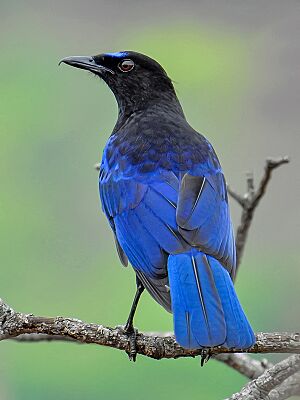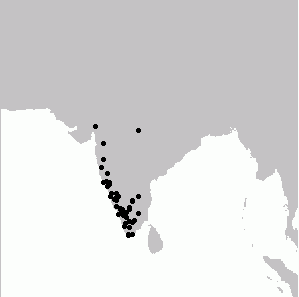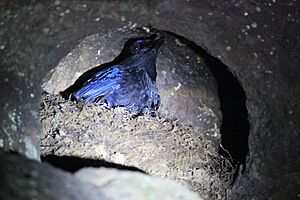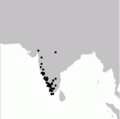Malabar whistling thrush facts for kids
Quick facts for kids Malabar whistling thrush |
|
|---|---|
 |
|
| from Mangaon, Raigad, Maharashtra | |
| Conservation status | |
| Scientific classification | |
| Genus: |
Myophonus
|
| Species: |
horsfieldii
|
 |
|
| Synonyms | |
|
Myiophoneus horsfieldii |
|
The Malabar whistling thrush (scientific name: Myophonus horsfieldii) is a beautiful bird known for its amazing songs. People sometimes call it the whistling schoolboy because its calls at dawn sound a lot like a human whistling! This bird lives in the Western Ghats and other hills in India, including parts of central and eastern India. It belongs to the thrush family, which includes many birds known for their lovely songs.
Contents
Discovering the Malabar Whistling Thrush
The Malabar whistling thrush is a special type of whistling thrush. It was first officially described in 1831 by a scientist named Nicholas Aylward Vigors. This bird is unique and doesn't have different subspecies. It was once thought to be the same as the Taiwan whistling thrush, but now we know they are different species.
What Does the Malabar Whistling Thrush Look Like?
This is a fairly large bird, usually about 25 to 30 centimeters (10 to 12 inches) long. It weighs around 100 to 130 grams (about 3.5 to 4.5 ounces).
Male thrushes have a dark, almost black body. They have shiny, metallic blue patches on their forehead and shoulders. Their back and chest also have glossy royal-blue scales, which look amazing! Their beak and legs are black.
Female thrushes look very similar to males. However, their blue scales are not as strong or bright. Young birds are black, but they have a glossy blue patch on their shoulders and blue edges on their wings. You can only see these blue colors when the light hits them just right. This is because of something called ultraviolet reflectance, which is common in many whistling thrushes.
Where Do Malabar Whistling Thrushes Live?
Malabar whistling thrushes usually live in dark, dense forests near rivers and streams. They love to search for food along the edges of rocky streams and rivers. You can find them in forests, areas where new plants are growing, and even in plantations. They live from the foothills up to about 2,200 meters (7,200 feet) above sea level. During the rainy season, they might even come down to the plains.
These birds are found all along the Western Ghats in southern India. They also live along the Satpura Range and in parts of Chhattisgarh, northwestern Orissa, and some areas of the Eastern Ghats. They do not migrate, meaning they stay in the same area all year round. However, they can sometimes travel to different places during winter. For example, one bird tagged in Mahabaleshwar in 1972 was found in Sampaje in 1976!
Behavior and Daily Life
These thrushes are usually seen alone or in pairs. If there's good habitat, they often live close to human homes.
The male thrush sings a beautiful, varied, and melodious whistling song from trees during the summer. They might sing for a long time around dawn, which is why they are called "whistling schoolboys." At other times of the day, they often make sharp, high-pitched whistles with one or two notes.
These birds were once popular as pet birds because they could learn whole tunes! They love to bathe often, usually in the mornings and evenings. On hot days, they might even bathe in the middle of the day.
What Do Malabar Whistling Thrushes Eat?
Malabar whistling thrushes eat a variety of foods. They are omnivores, which means they eat both plants and animals. Their main diet includes insects, snails, worms, crabs, and small frogs. They also enjoy fruits like drupes, and figs and berries that have fallen from trees. Sometimes, they have even been seen eating small snakes! There are rare reports of them eating longer snakes, like the Rat snake.
Reproduction and Life Cycle
Malabar whistling thrushes breed from March to December, usually starting when the monsoon rains arrive. During courtship, the birds chase each other and call out.
They typically build their nests in a hole or cavity along a stream bank. Sometimes, they might even use nearby buildings. In one study, most nests were found on rocks near streams. A few were found in tree holes or inside abandoned buildings.
The nest is shaped like a cup and is made of moss, bamboo roots, and grass. It has a wide base that gets narrower towards the top. The birds seem to use mud to stick the base of the nest to the rock. Nests are usually about 15 cm (6 inches) high and 7 cm (3 inches) deep. They are often about 125 cm (4 feet) off the ground. Most nest sites are about 6 meters (20 feet) from water and have a lot of rock cover. The nests are usually well hidden, and birds are more successful at raising their young when the nest is concealed. These birds often return to the same nesting spots year after year.
A female thrush usually lays 2 to 4 eggs. The eggs are a pale salmon pink color with speckles. Both the male and female birds take turns sitting on the eggs to keep them warm. This incubation period lasts for about 16 or 17 days.
Images for kids





